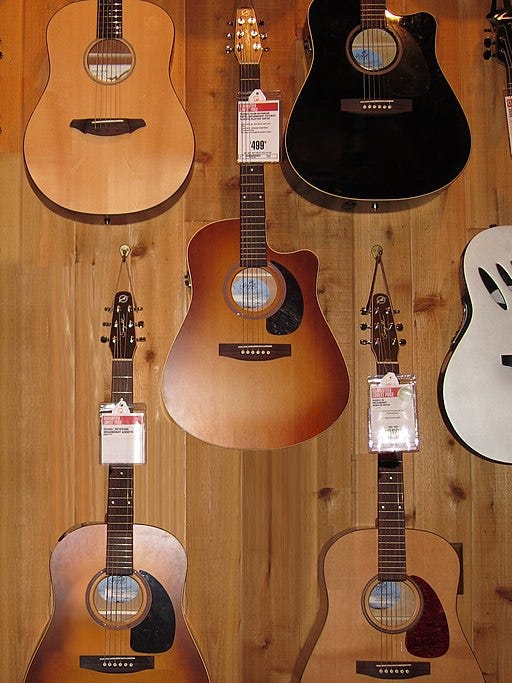The summer after my sophomore year of college, I interned for a summer at a church in Joplin, Missouri. The pay was not great, but to be fair I didn’t really know what I was doing, either.
Exhibit A: I remember one day we had purchased a bunch of food for an event, and I put the food that needed to be in the refrigerator in the freezer instead. Nothing like five gallons of frozen-solid milk on a hot day! Refreshing.
Nevertheless, over the summer I was able to save up enough money from my internship to buy a new guitar. I’d been playing guitar for several years by this point, but I still had my cheap starter Squier and Takamine that badly needed to be upgraded.
There was a local music store in town that I frequented in my search, and I remember walking in one day and seeing an acoustic guitar on display. It was a dreadnaught with a cutaway and a deep-brown cedar top. It caught my eye, and as I picked it up and began to play it, it felt good. Really good.
It was a Seagull S6 guitar, and I had to have it. As soon as I had the cash in hand, I went back and bought it.
I loved that guitar.
I played it all the time.
I knew it inside and out.
I’d play it in my dorm room. I’d sing worship songs with my friends in the chapel. I put on a free concert in the student union with it.
I even won my school’s talent show playing a song I had written on it.
It was my guitar, my companion in life.
Ten years later, and now I’m living in Colorado. I come home from work one day to find the front door of my house wide open. That’s weird, I thought. Maybe my wife didn’t get the door shut all the way when she went to work this morning.
I didn’t think much of it and went inside. I wasn’t in the house for more than a minute when I heard my wife’s car pull up. When she came in, I jokingly teased her about leaving the door open. “I didn’t leave the door open,” she replied.
We stood there and looked at each other.
About five seconds later, it clicked. We’ve been robbed!
I ran upstairs and saw a disheveled mess. The bed mattress was pulled off the frame. Papers were everywhere. Our computer was gone. My wife’s wedding rings were gone. My guitars were gone.
It was an awful, sickening feeling, one I wouldn’t wish on my worst enemy.
I immediately bought another Seagull guitar with the insurance money — a different model this time. Actually, I bought two: a six-string M series and a twelve-string S series. But neither felt right. Yes, they were Seagulls; yes, they were high-quality; but neither of them was my guitar.
I ended up selling them both after a year or two. I tried out a few more Seagulls over the years, including an Entourage, which was the newer version of that original S6 I had bought back in Missouri. But it didn’t matter: none of them played or felt like my guitar.
Fast forward another ten years, and now I’m living in the Puget Sound area. I was browsing on Reverb one day when I saw an older Seagull Artist Series guitar for sale for a very reasonable price.
This guitar looked just like my guitar.
It was the same model year as my guitar — 2001.
It had the same look as my guitar, down to the same wear on the sound hole.
It even came with the same case as my guitar had.
The only difference was that this guitar was the higher-end version of the one I had owned. It had a different inlay pattern, slightly different hardware, and a better preamp. But it cost just about the same amount that I had paid for my guitar in the summer of 2001. (In fact, I think it may have even been a little less.)
After I overcame the initial shock of what I was looking at, I made the decision to pull the trigger — how could I not?
As soon as I had it in my hands and played a chord, I knew this was the one. It played right, it felt right, it sounded right.
Everything about it was perfect.
It took ten years, lots of patience, and not a little bit of luck, but I finally got my guitar back.








